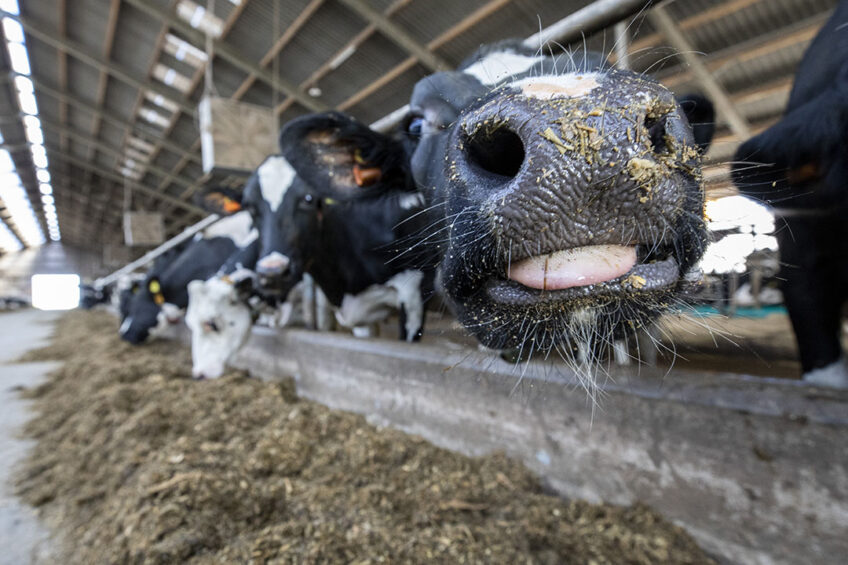A new look: Reasons behind negative energy balance in cows

Dairy cows experience negative energy balances at times, which can affect their production and fertility, but a new look at the reasons behind this has just been undertaken.
By combining the results from multiple sets of research over the past 30 years, AFBI in Northern Ireland has been able to help farmers understand complex biological systems, including the effects of negative energy balances.
AFBI has released the effects of negative energy balances on dairy cows from this approach. The research body says that body condition score is a better tool for monitoring energy balance than liveweight, and that the fat-to-protein ratio is strongly related to energy balance.
Energy balance explained
AFBI says that cows normally enter a period of negative energy balance in early lactation. This is due, in part, to the milk yield potential of dairy cows having increased, while their ability to consume sufficient food to support this extra milk has not increased at the same rate.
During periods of negative energy balance, the cow uses her body fat reserves to sustain her milk production, and this is reflected in a loss of body condition. Excessive negative energy balance, such as cows getting very thin, can lead to health problems and poor fertility.
Forensic look
Scientists at AFBI, together with University College Dublin and Teagasc, combined and analysed individual cow results from 27 experiments involving a total of 1,321 cows. This information has been used to examine factors influencing the energy balance of cows and to examine the use of milk fat-to-protein ratio as an indicator of energy balance.
Milk yields normally ‘peak’ around 5-7 weeks after calving, while intakes do not normally peak until 10-13 weeks after calving. This difference in the timing of peak milk yields and peak intakes helps explain why cows enter a negative energy balance. However, increasing the quality and nutrient density of the diet can allow cows to have higher nutrient intakes and as such, reduce energy balance to some extent. As expected, both milk yields and intakes increase with increasing lactation numbers.
Liveweights normally decrease during the first 5 weeks after calving before beginning to increase again. However, the body condition score normally decreases until approximately 10-15 weeks after calving.
Cows normally remain in the negative balance until approximately 10-15 weeks after calving. This highlights that the body condition score is a much better indicator of energy balance than liveweight.
Conducting body condition scoring can provide farmers with useful information to help manage the energy status of their herd. Peak negative energy balance is normally observed at weeks 2-3 post-calving, while older cows experience a more negative energy balance than younger cows.
Using milk quality stats
Body condition scoring can be time-consuming, and most farmers do not do this regularly. Consequently, there is research interest in identifying alternative indicators of a cow’s energy balance.
One indicator that might be used is the fat-to-protein ratio of milk. This ratio is determined by dividing the fat percentage of milk by its protein percentage. For example, if a cow produces milk with a fat content of 4.2% and a protein content of 3.3%, the milk will have a fat-to-protein ratio of 1.27.
The milk fat-to-protein ratio is already used by nutritionists as an early indicator of nutritional problems, with the ratio reflecting an ‘imbalance’ in milk fat and protein levels. For example, when cows mobilise body fat in early lactation, some of this fat ends up in the cow’s milk, and her milk fat percentage increases.
Similarly, when cows are deficient in energy, milk protein levels tend to fall. Cows with a high ratio may be at an increased risk of ketosis. Cows with a fat-to-protein ratio of greater than 1.5 are assumed to be ‘metabolically at risk’.
AFBI’s research showed that as energy balance becomes more negative, the fat-to-protein ratio of milk increases. Almost all cows with a fat-to-protein ratio greater than 1.5 have a negative energy balance. Therefore, AFBI suggests that cows with a fat-to-protein ratio greater than 1.5 are metabolically challenged.
However, there is also much variation within the data. For example, many cows with a fat-to-protein ratio between 1 and 1.5 were also in negative energy balance, while a fat-to-protein ratio within this range would not necessarily be considered to highlight cows that are ‘at risk’.
Based on this analysis, the milk fat-to-protein ratio alone cannot accurately predict individual cows’ energy balance. Instead, as currently used by nutritionists, it has a role as an early indicator of an imbalance in nutrition, especially when considered within the context of other diet and herd factors.
AFBI concluded that the body condition score is a better tool for monitoring energy balance than liveweight, and that the fat-to-protein ratio is strongly related to energy balance. However, the study has also demonstrated the limitations of using a fat-to-protein ratio to predict the energy balance of individual cows.
Join 13,000+ subscribers
Subscribe to our newsletter to stay updated about all the need-to-know content in the dairy sector, two times a week.










